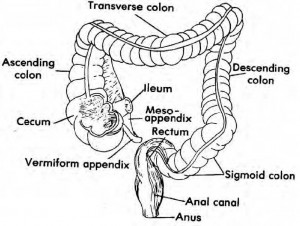a. The large intestine is about 5 feet long.
The cecum, located on the lower right side of the abdomen, is the first portion of the large intestine into which food is emptied from the small intestine.
The appendix extends from the lower portion of the cecum and is a blind sac. Although the appendix usually is found lying just below the cecum, by virtue of its free end it can extend in several different directions, depending upon its mobility.

Figure 1-2. Stomach, duodenum, and the accessory organs.
b. The colon extends along the right side of the abdomen from the cecum up to the region of the liver (ascending colon). There the colon bends (hepatic flexure) and is continued across the upper portion of the abdomen (transverse colon) to the spleen. The colon bends again (splenic flexure) and goes down the left side of the abdomen (descending colon). The last portion makes an S curve (sigmoid) toward the center and posterior of the abdomen and ends in the rectum.
c. The main function of the large intestine is the recovery of water and electrolytes from the mass of undigested food it receives from the small intestine. As this mass passes through the colon, water is absorbed and returned to the tissues. Waste materials, or feces, become more solid as they are pushed along by peristaltic movements. Constipation is caused by delay in movement of intestinal contents and removal of too much water from them. Diarrhea results when movement of the intestinal contents is so rapid that not enough water is removed.
